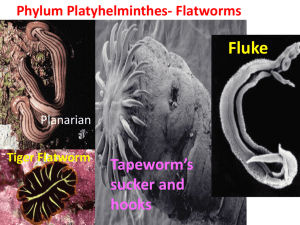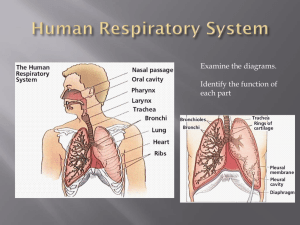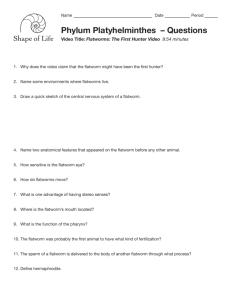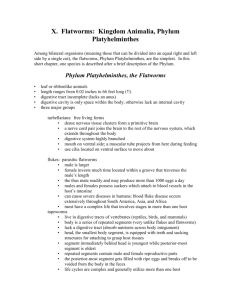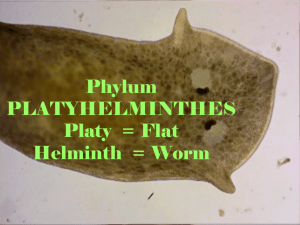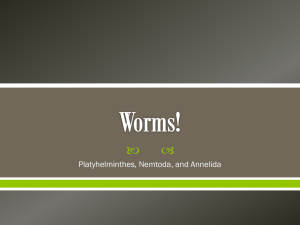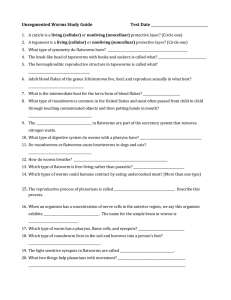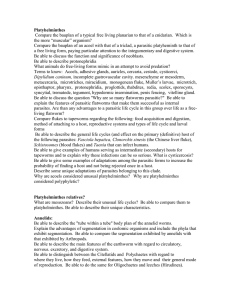The Kingdom Animalia - Valhalla High School
advertisement
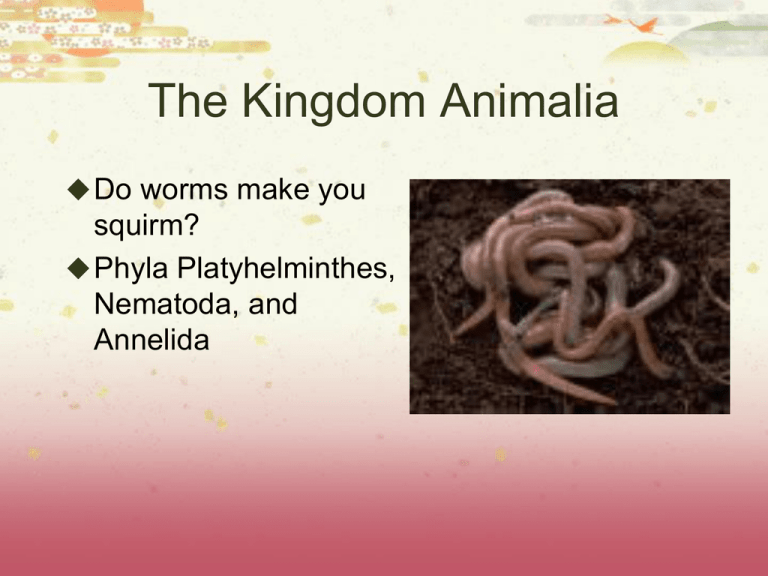
The Kingdom Animalia Do worms make you squirm? Phyla Platyhelminthes, Nematoda, and Annelida Phylum Platyhelminthes The platyhelminthes is the first of three phyla that are made up of worms. The platyhelminthes are the flatworms. The flatworms Unlike the porifera and the cnidarians, flatworms exhibit three cell layers as will all animal phyla from this point on. Flatworms have a basic digestive tract that is two-way. This means that food is ingested and solid wastes are eliminated through the same opening. Body plan Flatworms exhibit bilateral symmetry, just like you do. Flatworms are capable of amazing feats of regeneration. Cut a flatworm in half, and two worms will grow. A whole new flatworm can grow just from a piece of another flatworm Flatworm feeding Marine and aquatic flatworms are carnivorous predators and scavengers. Other flatworms, such as flukes and tapeworms are parasites. Tapeworms can grow to lengths of up to 50 feet! Reproduction in flatworms As mentioned, flatworms can reproduce asexually through regeneration. They can also reproduce sexually. Each flatworm is a hermaphrodite, meaning that they produce both sperm cells and egg cells. Phylum Nematoda Numerically the nematods are the must abundant of all animals. They are sometimes called roundworms. A small sample of soil can contail thousands of these tiny worms. Some are predatory and feed on bacteria. Many others are parasites of insects and other larger animals Body plan Nematods exhibit the “tube within a tube” body plan. They have a one-way digestive tract, just like we do. They are much more complex than the earlier phyla we’ve looked at so far. Reproduction The various ways that nematodes reproduce is staggering. For our purposes we will simply say that nematodes reproduce sexually. Nematodes and humans First the bad news. There are several diseases in humans which are caused by nematodes. Of particular note is a nematode called filaria. Filaria attacks the human lymphatic system causing the disease elephantitis On the other hand Not all nematodes are bad. Many of them are helpful to humans because they attack pests which destroy our crops. They are used as biological control agents. Some nematodes attack bugs and insects, while others attack dangerous types of nematodes. Phylum Annelida Members of this phylum are commonly referred to as the segmented worms. The most common member of this phylum is the earthworm. Annelids are found in marine environments, freshwater and moist terrestrial soils. Bristle worm Mildly toxic if handled Body plan Like the other two worm phyla, annelids display bilateral symmetry. They have the tube within a tube body plan. They are made up of successive segements, each containing the same internal organs. Reproduction Annelids are able to reproduce asexually through regeneration, but not to the same extent as the flatworms. All members are hermaphrodites and are able to reproduce sexually. Feeding Earthworms feed by burrowing through the soil, ingesting soil, and digesting nutrients. Earthworm activity increases the quality of the soil. Leeches are aquatic blood-sucking parasites. Many marine annelids have powerful jaws and are predatory. Deep sea vent tubeworms are also annelids. They are fed by symbiotic chemosynthetic bacteria.
